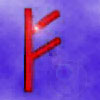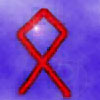 |
|
|
|
 |
 |
 |
| Ancient Earth Religions |
| R u n e s |
| HISTORICAL BACKGROUND |
|
| WHAT ARE RUNES? |
| Runes are an alphabetic script used by the peoples of Northern Europe from the first century c.e. until well into the Middle Ages. In addition to their use as a written alphabet, the runes also served as a system of symbols used for magic and divination. Runes came into disuse as the Roman alphabets became the preferred script of most of Europe, but their forms and meanings were preserved in inscriptions and manuscripts. |
|
| The primary characteristic which distinguishes a runic alphabet from other alphabets is that each letter, or rune, has a meaning. For example, whereas "ay", "bee", and "cee" are meaningless sounds denoting the first three letters in our alphabet, the names the first three runes, "fehu", "uruz", and "žurisaz" are actual words in the Germanic language, meaning "cattle", "aurochs", and "giant", respectively. |
|
| Runes also have magical and religious significance as well, thus transforming the simple process of writing into a magical act. They are also used for divinatory readings and to create magical spells. Today, runes have been rediscovered as a symbolic system and have gained immense popularity as a means of divination. however, much more than a curious alternative to Tarot cards for telling fortunes. They provide a key to understanding the lives beliefs of the ancient people who created them, and have much to teach us about a way of life that was perhaps more intimately connected to the natural world, and to the realm of spirit, than our own. |
|
| HISTORY AND ORIGIN OF THE RUNES |
| What we now know as the runic alphabet seems to have developed from two distinct sources - one magical, one literate. Pre-runic are symbols, or hällristningar, have been found in various Bronze Age rock carvings, primarily in Sweden. Some of these symbols are readily identifiable in the later alphabets, while others represent ideas and concepts which were incorporated into the names of runes (sun, horse, etc.). The exact meanings of these sigils are now lost to us, as is their original purpose, but they are believed have been used for divination or lot-casting, and it is fairly certain that they contributed to the magical function of the later runic alphabets. |
|
| There is some debate over the origin of the "alphabet" aspect of the runes. Cases have been made for both Latin and Greek derivation, but historical and archaeological evidence strongly indicates a Northern Italic origin. The parallels between the two alphabets are too close to be ignored, particularly in the forms of the letters, as well as in the variable direction of the writing. This would also explain why so many of the runes resemble Roman letters, since both Italic and Latin scripts are derived from the Etruscan alphabet (itself a branch of the Western Greek family of alphabets). |
|
| This theory would place the original creation of the futhark sometime before the 1st. century c.e., when the Italic scripts were absorbed and replaced by the Latin alphabet. Linguistic and phonetic analysis points to an even earlier inception date, perhaps as far back as 200 b.c.e. When the northern tribes began integrating the Italic alphabet into their own symbolic system, they gave the letters names relating to all aspects of their secular and religious lives, thus transforming their simple pictographs into a magical alphabet which could be used for talismans, magical inscriptions and divination. |
|
| The name "futhark", like the word "alphabet", is derived from the first few letters in the runic sequence, which differs considerably of the Latin alphabet and is unique amongst alphabetic scripts. The futhark originally consisted of 24 letters, beginning with F and ending with O, and was used by the northern Germanic tribes of Sweden, Norway, Denmark, and Northern Germany. This form of the runes is known as the Elder, or Germanic Futhark. |
|
| Sometime around the fifth century AD, changes occurred in the runes in Frisia (the area around the northern Netherlands and north-western Germany). This period coincided with the Anglo-Saxon invasions from this area and the appearance of similar runes in the British Isles. The forms of several of the runes changed, notably the runes for A/O, C/K, H, J, S, and Ng. Also, changes in the language led to between five and nine runes being added to the alphabet to compensate for the extra sounds, and several runes were given different corresponding letters. This alphabet has become known as the Anglo-Saxon Futhorc. |
|
| In Scandinavia, the Elder Futhark remained in use until some time around the eighth century (the time of the Eddas), when changes the Old Norse language occurred, and corresponding changes in the runic alphabet were made to accommodate the new sounds. However, unlike the Anglo-Saxon Futhorc, the Younger Futhark (as it is now called) reduced the number from 24 to 16, and several runes came to represent multiple sounds. |
|
| The forms of the runes were also changed and simplified. There are several variations of this futhark - Danish, long branch, Norwegian, dotted, etc. form of the runic alphabet spread from Denmark north into Sweden and Norway, and was carried into Iceland and Greenland by the Vikings. It is possible that they were also brought to North America with the Finland expeditions, but so far no authenticated inscriptions have been found. |
|
| The Runic Revival: |
| The runes, primarily in their Younger form, remained in common use until well into the 17th. century. Up until this time, they were everything from coins to coffins, and in some places their use was actually sanctioned by the Church. Even the common knew simple runic spells, and the runes were frequently consulted on matters of both public and private interest. |
|
| Unfortunately, with the magical arts, they were officially banned in 1639 as part of the Church's efforts to "drive the devil out of with Europe". The rune masters were either executed or went underground, and the knowledge of the runes may well have died with them. Some of the knowledge was passed on in secret, but it is almost impossible to separate ancient traditions from more modern esoteric philosophies in such cases. |
|
| Perhaps the darkest period in the history of runic studies was their revival by German scholars connected with the Nazi movement in the that 20's and 30's. What began as a legitimate folkloric resurgence unfortunately became so tainted by Nazi ideology and racism that the research from this period was rendered all but useless to any serious student of runic lore. After the Second World War, the runes fell into disfavour as a result of their association with Nazism, and very little was written about them until the fifties and sixties. It was not until the mid-eighties, with the widespread appeal of the "New Age" movement and revival of Pagan religions (especially the Asatru movement) that the runes regained their popularity as both a divinatory system and a tool for self-awareness. |
|
| ©1996 by Jennifer Smith |
| To know more about runes, to interpret their meanings and more, visit Jennifer Smith's Website "The Runic Journey". |
|
|
| The Runes in the Havamal |
|
| Order of Charm: Intent: Primary Rune and Supporting Runes |
| The First Charm: Help in Sorrow or Distress Fehu, Inguz, Laguz |
| The Second Charm: Healing Uruz, Jera, Sowulo |
| The Third Charm: Fettering Foes Thurisaz, Isa, Nauthiz |
| The Fourth Charm: Releases Fetters Ansuz, Fehu, Inguz |
| The Fifth Charm: Ability to stop a Dart Raido, Isa, Kenaz |
| The Sixth Charm: Returning Curses to sender Hagalaz, Jera, Raido |
| The Seventh Charm: To put out a Fire ablaze in a Hall Isa, Laguz, Nauthiz |
| The Eighth Charm: Ability to bring about Reconciliations Gebo, Mannaz, Wunjo |
| The Ninth Charm: Control Sea Winds Gebo, Ansuz, Raido |
| The Tenth Charm: How to Confuse Spell Senders Dagaz, Ehwaz, Laguz |
| The Eleventh Charm: Protecting Friends in Battle Sowulo, Algiz, Ansuz |
| The Twelfth Charm: Necromancy Hagalaz, Teiwaz, Kenaz |
| The Thirteenth Charm: Protecting a Young Warrior with water Gebo or Inguz, and Laguz, Algiz |
| The Fourteenth Charm: Knowledge of all Gods and Elves Eihwaz, Ansuz, Mannaz |
| The Fifteenth Charm: Gives power to the Aesir, prowess to the Elves and Foresight to Odin Sowulo, Raido, Kenaz |
| The Sixteenth Charm: To attract a Lover Kenaz, Jera, Inguz |
| The Seventeenth Charm: To keep Romance in a Marriage Gebo, Inguz, Ehwaz |
| The Eighteenth Charm: Union of the Male and Female To be discovered by the Reader |
|
 |
|




